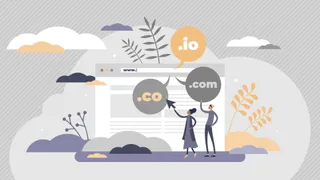
The 2026 dotBrand application: A rare opportunity to secure future options
IP and brand professionals need to consider the potential benefits presented by next year’s window for new TLDs, says Phil Lodico, head of GoDaddy Corporate Domains
In the corporate domain space, we spend countless hours planning for the predictable and seeking out the direct return on investment.
But what about the rare, high-impact opportunities you can’t predict? That’s where the 2026 application window for new top-level domains (TLDs) comes in. This is the first opportunity in over a decade to secure your branded TLD, your own dotBrand (think .abbvie or .nike).
For IP and brand professionals at large corporations, this timing demands a new approach. The decisions we make today can’t just be about immediate needs; they must secure optionality for a digital future we can’t yet see, which can impact departments we don’t often work with or might not even exist yet.
The history and the core question
Fortunately, this happened once before, and history can be our guide. In 2012, ICANN opened a window to apply for new gTLDs, leading to nearly 2,000 applications.
Many brands, such as Microsoft, Google, and Amazon, secured their own branded TLDs, though none were used right away. In all cases, it was many years before they began leveraging the long-term strategic value of the asset in various ways, like consolidating their entire software suite under cloud.microsoft or launching new trustworthy hubs like pharmacyservices.amazon.
While that strategy made sense then, and likely does again, the landscape today isn’t the same as it was in the last round. Technology is moving fast, bad actors are getting better, and there is an ever-growing desire for more security, differentiation, personalisation, and control.
As someone who has been in the domain space for over 25 years and who assisted in over 135 applications in the 2012 round, one of the most common questions faced then and now is: how can I use it? While traditionally important in decision-making, that framework doesn’t work here for most, though there are exceptions for those with clear and present opportunities or dangers.
The critical question does not have to be rooted in finding immediate production value or use cases. The primary strategic question should be: Is there the possibility that we would ever need or require a dotBrand for this name, based upon our own needs or a shift in the marketplace or technology over the next 15 years?
This realisation breaks the dotBrand decision into two distinct, separate phases, shared in my team’s dotBrand Application Strategy Guide:
Phase 1: The application decision (act now)
For most, applying for a dotBrand TLD can be simplified into buying an option. You are purchasing the exclusive right to own, control, and deploy that piece of internet infrastructure, at some point in the future—should you choose to.
You don’t need a detailed go-to-market strategy to apply, and even the best laid plans will likely change between when you apply in 2026 and when you get it in 2028. The application window opens in April 2026 and closes again in June (perhaps for more than a decade). The first decision is simply: should I apply?
Frame the decision around the following questions; more considerations could be found in the guide:
- Do I have a globally recognised brand that is tied to billions of dollars in revenue?
- Do consumers associate our brand name with trust online?
- Do others have rights to our brand name anywhere else in the world?
- Is our brand unique or somewhat generic? Could another company apply for it, as happened with .coach, where it was ultimately outbid and lost?
- Would I be comfortable with another company that has shared rights to our mark owning the TLD?
- Is there a chance that our company might want or need a TLD in the next ten years?
Phase 2: The deployment strategy (optimise later)
This doesn’t mean you shouldn’t consider how you could use it or whether it could have value in the near term. Ultimately, there is real value to be extracted, though the point here is: it’s helpful not to get stuck on what that is out of the gate.
If you choose to apply and end up owning and operating a TLD, there are many general benefits outside of any unique business problems it could solve in the future. For example:
- Security and trust: A dotBrand TLD provides an undeniable legitimacy signal for your organisation. A brand’s job is to convey trust, and with a dotBrand that displayed ownership is automatic in all domains and websites you use. For an era where phishing attacks are prevalent and the average cost of a data breach is approximately $4.4 million in 2025 (IBM), controlling your own namespace helps secure your defence perimeter.
- Infrastructure control: You gain the ability to mandate high security standards. By adding your dotBrand to the HSTS-preload list, you ensure any website launched on your TLD can never be forced onto an insecure connection—the “gold standard of website security”.
- Brand protection: Owning the namespace means no third party can own a domain in that ecosystem.
Leading brands have demonstrated diverse approaches to get value:
- Global consolidation: Canon migrated from canon.com to global.canon, unifying brand identity and enhancing security across all international sites.
- Product launch/campaigns: CERN launched clear.cern for an exclusive landing page for their CLEAR electron test facility.
- Internal tools and trust: FOX uses getstarted.fox as a single stop for new employee onboarding, creating a clear, trusted destination for sensitive internal processes.
- Core migration: Microsoft consolidated its Microsoft 365 apps under cloud.microsoft for improved user experience, consistency, and single sign-on security.
These examples demonstrate that whether you use it comprehensively, as Google does with its suite of security and product TLDs (safety.google, ai.google), or selectively, as Apple does with its event and resource domains (experience.apple), value is for the taking.
Secure the future, don’t forfeit the option
I won’t tell you that you absolutely need a dotBrand. In fact, it is not for everyone, but I do advise making a proactive decision, rather than letting this round pass you by because you don’t see the immediate ROI. The long, time-bound nature of the application window, coupled with the off-the-shelf security benefits alone, justifies serious consideration.
It doesn’t matter whether you’ll immediately transform your digital presence; what matters is whether you can afford to forfeit the option to do so years from now.
For those still questioning the path forward, my team and I have developed a full strategic guide to aid your decision-making you should take a look at.
Phil Lodico is head of GoDaddy Corporate Domains (GCD), an innovative domain name registrar which leverages both experienced consulting services and an advanced domain management technology platform to assist corporate clients. Lodico is a longstanding veteran in the domain industry, having founded and run many successful organizations for over 20 years. Phil can be contacted at phil@gcd.com.
Editor's picks
Editor's picks
More articles
Copyright © worldipreview.com 2024 | Headless Content Management with Blaze

